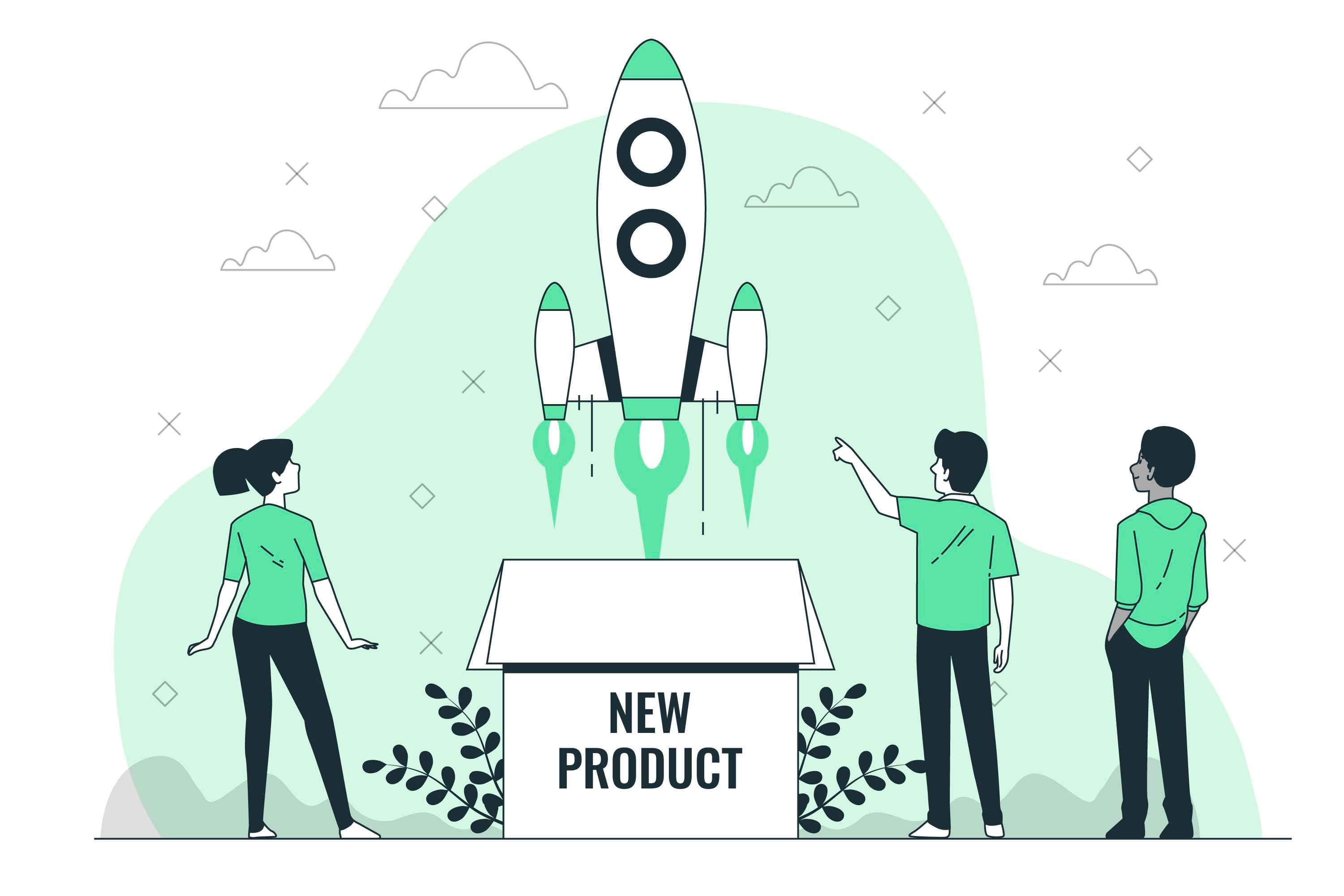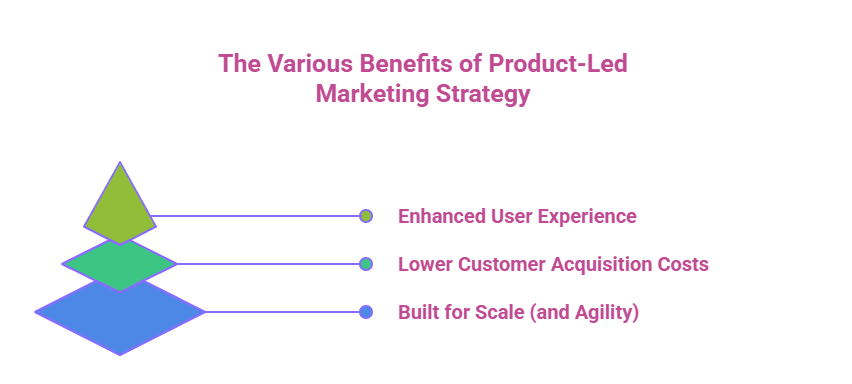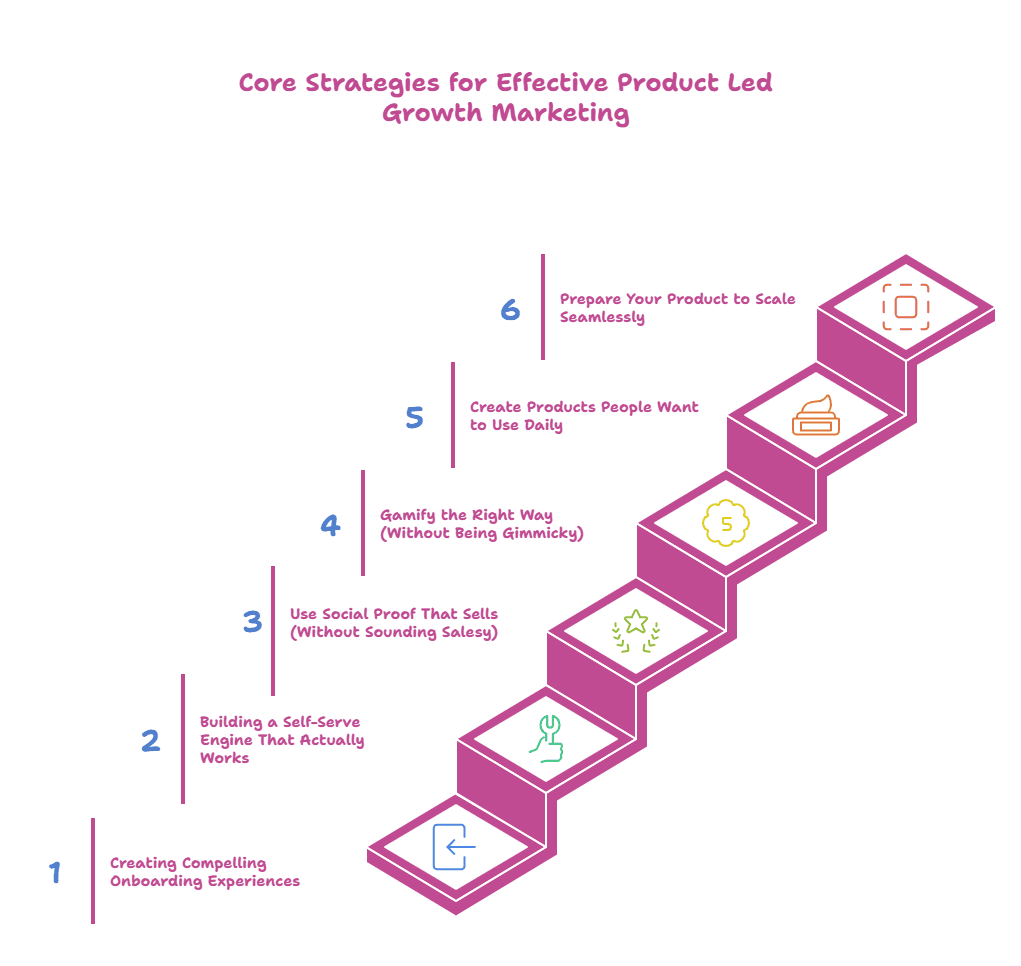Product-Led Growth Strategy: How to Scale Without Selling

Acquiring Users is Hard. Keeping Them? Even Harder. You might have tried email campaigns, demos, and discount offers, but users still churn before seeing real value. Does this sound familiar?
Here’s the truth: modern SaaS users don’t want to hear about your product. They want to experience it. That’s where a Product-Led Growth Strategy flips the script.
It’s not about big promises. It’s about building trust—through usage, not persuasion.
With a PLG strategy, your product becomes your strongest sales channel. Users sign up, explore, and hit their “aha” moment faster—without the need for constant hand-holding.
This approach is built for SaaS teams tired of chasing leads and ready to scale smarter and more sustainably.
In this blog, we’ll explain what a Product-Led Growth Strategy is, how to build one, and why it’s the future of customer-centric growth.
What is a Product Led Growth Strategy?
Are you tired of long sales cycles and users dropping off before they see value? At its core, a PLG strategy puts your product in the driver’s seat. Instead of relying on heavy sales pitches or drawn-out nurturing, your product shows users its value—right from the start.
Think about how Slack or Dropbox won users over: no hard sell, just a freemium product experience that delivers immediate value. That’s the power of a product-led growth strategy as a business strategy.
This strategy centers everything around real usage—acquisition, conversion, and retention. Marketing generates demand by promoting product experiences. Sales use in-product signals to qualify leads. Customer success focuses on helping users unlock value faster.
It’s a smarter, faster, and more efficient model. Lower CAC, higher activation, and better user satisfaction.
And best of all? Users upgrade because they want to—not because someone followed up 12 times.
Distinguishing between Product-Led Growth and Sales-Led Growth
While both Product-Led Growth (PLG) and Sales-Led Growth (SLG) strategies aim for customer acquisition and business growth, they differ significantly in their approach. Let's check out these differences.
Product-Led Growth (PLG) | Sales-Led Growth (SLG) |
|---|---|
Relies on the product to drive customer acquisition and retention | Depends heavily on a sales model team, including customer success teams, to move customers through the sales cycle. |
Puts the customer’s firsthand experience at the forefront | Focuses on moving the buyer from Point A to Point B in a sales funnel |
Encourages self-serve model for lower Customer Acquisition Cost (CAC) | Higher CAC due to increased reliance on the sales team |
Offers a freemium or free trial version of the products | Often requires prospective customers to request a demo or engage with a sales rep |
Simply put, PLG marks a critical shift from vendor-driven sales processes to consumer-centered buying experiences. It empowers users to experience firsthand the utility and benefits of a product, leading to higher user satisfaction, stronger customer retention, and ultimately improved business profitability.
The Various Benefits of Product-Led Marketing Strategy

Product-led marketing isn’t just a buzzword—it’s a smarter, faster, and more sustainable way to grow. By putting your product at the center of the user journey, you’re giving potential customers precisely what they want: proof that it works, aligning with customer needs, which ultimately enhances your marketing efforts. Here's why it's a game-changer:
1. Enhanced User Experience
Today’s users hate being sold to—but they love solving problems on their own terms. Product-led marketing taps into this by giving them the keys to explore.
Trust builds naturally when users experience value firsthand, without the pressure of a pitch.
It’s all about real value, not flashy promises. Let users feel the impact before asking for their card.
Friction disappears—no sales calls, no upfront commitment—just smooth, self-guided discovery.
The result? A user experience that feels intuitive, empowering, and conversion-ready.
2. Lower Customer Acquisition Costs
Why burn the budget on ads and bloated sales teams when your product can do the heavy lifting?
Users onboard themselves.
Upgrades happen organically.
CAC drops, and ROI climbs.
You replace expensive acquisition funnels with a self-serve motion that scales. It’s lean, efficient, and built for modern buyers who’d rather try than talk.
3. Built for Scale (and Agility)
Because your product is the driver, scaling becomes seamless. Whether you have 1,000 users or 100,000, your onboarding flow doesn’t need extra hands.
Do you want to tweak a feature or test onboarding flows? Go for it—many platforms provide real-time data to iterate quickly.
Global expansion? Your product’s already doing the pitch in every timezone
Core Strategies for Effective Product Led Growth Marketing

Adopting PLG entails implementing strategic approaches that facilitate users' firsthand experience of the product's value. Let's check out these strategies in detail in the following section:
1. Creating Compelling Onboarding Experiences
Onboarding isn’t a checklist. It’s your first real conversation with the user—and in a product-led world, that conversation needs to lead straight to value.
Think about the first time you used Notion or Canva. They didn’t overwhelm you with features or walls of text. They walked you to a quick win. That’s the goal: guide users to their first “aha” moment fast.
How to Make It Work:
Personalize It: Ask the right questions upfront—What’s your role? What are you here to do?—and tailor the flow accordingly. A product manager exploring analytics doesn’t need the exact walkthrough as a marketer setting up a campaign.
Show, Don’t Tell: Skip the long tours. Let users do something right away. Think: setting up their first dashboard, sending their first invite, and generating a basic report.
Ask for Feedback Early: Post-onboarding, add a quick rating prompt. Something as simple as “Was this helpful?” can unlock a goldmine of insight for iteration.
Evolve, Always: A/B tests different flows, cut friction, and adapt as your product grows. What worked when you had 100 users may not work at 10,000.
Great onboarding doesn’t just convert—it creates confidence. And confident users stick around.
2. Building a Self-Serve Engine That Actually Works
Today’s users don’t want a sales demo—they want to try the product on their own terms. A self-serve model gives them that power.
The best self-serve products are almost invisible. They guide without hovering and educate without overwhelming. Think of how Calendly lets you book your first meeting in minutes—no hand-holding needed.
Make Self-Serve Stick:
Design for Humans, Not Engineers: Your UX should feel intuitive from day one. If users need to read a manual to navigate the UI, you lose them.
Provide just-in-time help: Tooltips, micro-videos, embedded guides—think “help that finds you,” not a 50-page help center.
Offer Safety Nets: Include live chat or a responsive bot. Autonomy is significant, but no one wants to feel stuck in silence.
A strong self-serve experience removes excuses to churn—and fuels trial-to-paid conversion like nothing else.
3. Use Social Proof That Sells (Without Sounding Salesy)
When did you last sign up for something without checking the reviews?
Exactly.
In PLG, social proof is your sales team. But we’re not talking forced testimonials or corporate jargon.
Here's what works:
Real Reviews: Share honest feedback from users (warts and all). Highlight them on your pricing page, product tour, and onboarding screens.
Mini Case Studies: Not 10-page PDFs—think 3-line success blurbs like “How We Cut Reporting Time by 80% Using [Your Product]” with a clear before/after.
User-Generated Content: Encourage screenshots, walkthroughs, or feature tips from users and reward them with shoutouts or swag.
People trust people. Build a user community that discusses your product even when you’re not in the room.
4. Gamify the Right Way (Without Being Gimmicky)
Gamification isn’t about slapping badges on your UI. It’s about using human psychology to build engagement habits.
Do you want users to explore more features or log in daily? Game mechanics can help.
Practical Gamification Tactics:
Progress Bars: Showing setup completion encourages follow-through.
Milestones & Rewards: Celebrate when users hit usage milestones (e.g., “First 5 Projects Created!”).
Friendly Competition: Leaderboards or usage stats can drive participation in team-based products.
Just keep it purposeful. It backfires if it feels forced or irrelevant to the product’s core use.
5. Create Products People Want to Use Daily
The ultimate PLG win? When your product becomes a habit.
Growth becomes inevitable if users keep coming back—not because they have to, but because they want to.
How to Get There:
Deliver Value Fast: The first win should come in minutes, not hours.
Build in Triggers: Can’t-miss reminders, progress nudges, or daily digests pull users back in.
Reward Repetition: Whether it’s streaks, content unlocks, or visual feedback, make frequent use feel rewarding.
Think of how Grammarly or Google Calendar blends seamlessly into a user's day. That’s the benchmark.
6. Prepare Your Product to Scale Seamlessly
PLG growth often feels like flipping a switch. One day, you're at 1,000 users. The next week? 20,000.
Can your product handle that?
Set the Foundation:
Design for Modularity: Add features without breaking everything. Think plug-and-play, not spaghetti code.
Invest in Performance Early: Speed = experience. If your app lags, users bounce—even if it works.
Protect Trust: As usage scales, so do security expectations. Guard user data like it’s your own.
By scaling smartly from team tools to global infrastructure, you can get there.
5 Critical Metrics to Drive Product-Led Growth
Tracking the right growth metrics is the backbone of any successful product-led growth strategy. Without them, you're guessing instead of optimizing user experience and value. Below, we’ll break down 5 critical metrics that your product team can use to identify what’s working, what’s not, and how to grow faster—without adding friction.
1. Free-to-Paid Conversion Rate
This metric tracks how well your free trial model users are transitioning to paid plans, including the number of users converting to paid subscriptions. Monitoring it gives you insights into the effectiveness of your freemium model and helps identify key areas to enhance the user journey for better upgrades.
2. Time to Value (TTV)
Time to Value measures how quickly users recognize and experience your product's core benefits. Reducing TTV ensures that users immediately understand your product value, increasing their chances of sticking with it.
3. Product-Qualified Leads (PQLs)
PQLs identify users actively engaging with your product and show clear signs of becoming paying customers. Tracking these leads allows you to focus on the highest-potential users, increasing the likelihood of conversion.
4. Customer Activation Rate
Customer Activation Rate tracks how fast new users take meaningful actions within your product after signing up. A high rate signals a smooth onboarding and early user engagement, which is crucial for long-term retention.
5. Net Revenue Churn
Net Revenue Churn helps you understand the percentage of lost revenue due to customer churn. Monitoring this allows you to refine your product offerings and retention strategies, ensuring a healthier average revenue flow.
2 Examples of Successful Product-Led Marketing Strategy
The best product-led marketing doesn’t talk users into converting—it shows them why they should. Here’s how Slack and Dropbox mastered that approach.
1. Slack – Marketing Through Experience
Slack didn’t market through loud ads. It lets the product speak for itself.
The freemium model was the first touchpoint—teams could explore the product without a demo or sales call.
Users got immediate value: real-time messaging, searchable threads, and fewer emails.
The “Aha!” moment? When team workflows noticeably improved, without setup headaches.
Slack’s marketing was the product. By instantly letting users self-serve and experience value, the tool generated organic buzz, referrals, and upgrades without traditional funnels.
2. Dropbox – Product as the Message
Dropbox marketed itself as being incredibly useful—right from the start.
When you dropped a file in, it solved a problem (file access anywhere).
No sales rep, no explainer video—just clear value on day one.
Its referral program was marketing: users got more storage, and Dropbox got more users. Win-win.
Instead of pushing ads, Dropbox leaned on the product’s simplicity and utility to spread awareness. That’s textbook product-led marketing—where growth is baked into usage.
How SmartCue Amplifies Your Product-Led Growth Strategy?
When it comes to implementing a Product-Led Growth Strategy, having the right tools can make all the difference. SmartCue is one such tool that helps transform your product experience into a growth engine. It empowers teams to effortlessly guide users through their journey, delivering quick value and driving higher activation rates by enabling them to create interactive self-serve demos.
With SmartCue, you can personalize the onboarding process, provide in-product engagement, and increase user adoption with minimal effort. Tracking user behavior helps you optimize the experience for better retention while reducing the need for sales interventions. The result is faster onboarding, greater product usage, and a more efficient path to conversion, driving your Product-Led Growth strategy forward with ease.
Start your 14-day free trial today and see how SmartCue can supercharge your PLG strategy.
Conclusion: Product-Led Growth Isn’t a Tactic — It’s the Future
Product-led growth isn’t just a trend—it’s a shift in how modern software companies build, sell, and scale. In a world where users demand instant value and autonomy, aligning the entire organization around delivering the best possible experience gives companies a clear competitive edge by letting the product do the talking.
This strategy isn’t about adding a few onboarding flows or badges for engagement — it’s about embedding value, usability, and customer empathy at the core of your product experience. Whether it's guiding users to their first "aha" moment, enabling self-serve exploration, or turning loyal customers into vocal advocates — every touchpoint becomes a lever for growth.
And the payoff? Lower acquisition costs. Higher retention. Stronger customer loyalty. Sustainable, compounding growth.
The market is already shifting. The real question is: will your product lead or be left behind?
Now’s the time to build a product that doesn’t just convert — it sticks, scales, and sells itself.
Frequently Asked Questions
Which is more effective for growth, PLG or SLG?
Both PLG and SLG have their merits and may suit different situations. However, given the prominence of tech-savvy buyers who prefer self-service options and direct product experiences, PLG has been gaining an edge in being more cost-effective and aligned with evolving market trends.
What are the three pillars of product-led growth?
The three pillars of Product-Led Growth are Acquisition, Activation, and Monetization. Acquisition involves attracting potential users to the product, Activation focuses on providing meaningful initial experiences, and Monetization entails converting free or trial users into paying customers, ultimately impacting customer lifetime value.
What tools are essential for implementing a PLG strategy?
Essential product led growthtools include intuitive onboarding platforms, product analytics tools to track user behavior, marketing automation software for nurturing user relationships, and intelligence tools to identify power users or potential leads. Social media platforms are also essential for spreading user-generated content.
Why is product-led growth considered the future of marketing?
Product-led growth is the future of marketing because it aligns with increasing consumer preferences for firsthand product experiences over traditional sales tactics. It allows faster scaling at lower costs, enhances customer experience and end user experience, and leads to improved customer retention - making it a promising path forward for sustainable growth.
Comments
Your comment has been submitted successfully!